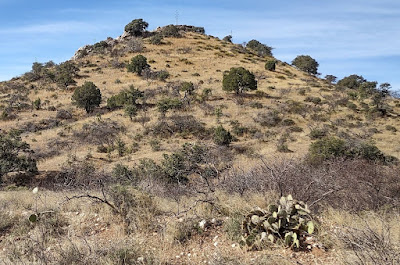 |
| Primroses in the morning |
I stopped keeping running lists as a sidebar but still keep my own lists of Books Read. So far in 2023 the total is fifty-seven, with one more day left in the first quarter of the year. I’m sure my reading pace will slow once I’m back in Michigan, busy in my bookstore and at home, selling books, mowing grass, and hanging laundry on the line, but for now, here is the list as it stands on March 29. If it were annotated, it might be more meaningful, but I don’t have the heart. The sad, crazy state of my country is too much with me.
 |
| Bajada lupine |
1. Spragg, Mark. An Unfinished Life (fiction)
2. Moor, Robert. On Trails (nonfiction)
3. Brontë, Charlotte. Shirley (fiction)
4. Irving, Washington. A Tour on the Prairies (nonfiction)
5. Swan, Walter. How to Be a Better Me (nonfiction)
6. Maxwell, Gavin. A Reed Shaken by the Wind (nonfiction)
7. Ferber, Edna. Show Boat (fiction)
8. Simeti, Mary Taylor. On Persephone’s Island: A Sicilian Journal (nonfiction – uncorr. proofs, 1986)
9. Fellowes, Julian. Snobs (fiction)
10. Keillor, Garrison. Pontoon (fiction)
11. Sumner, Cid Ricketts. Tammy Out of Time (fiction)
12. Jance, J.A. Unfinished Business (fiction)
13. Jance, J.A. Until Proven Guilty (fiction)
14. Abels, Harriette. Mystery on the Delta (fiction – YA)
15. Rhodes-Pitts, Sharifa. Harlem is Nowhere: A Journey to the Mecca of Black America (nonfiction)
16. Robertson, Mary E. I’m Sorry For Your Loss: One Woman’s Journey Through Love, Loss & Recovery (nonfiction – ms.)
17. Postgate, Raymond. Verdict of Twelve (fiction)
18. Jance, J.A. Taking the Fifth (fiction)
19. Robinson, Shauna. The Banned Bookshop of Maggie Banks (fiction)
20. Sanders, Michael S. From Here, You Can’t See Paris: Seasons of a French Village and Its Restaurant (nonfiction)
21. Durrell, Lawrence. Mountolive. (fiction)
22. Collins, Billy. The Trouble with Poetry (poetry)
Cain, Susan. Bittersweet: How Sorrow and Longing Make Us Whole (nonfiction)
23. Frank, Bruno. The Persians Are Coming (fiction)
24. Hoag, Tami.; The Bitter Season (fiction)
25. Gallico, Paul. The Abandoned (fiction)
26. Abram, David. Becoming Animal: An Earthly Cosmology (nonfiction)
27. Collins, Billy. (poetry)
28. Elliott Andrea. Invisible Child: Poverty, Survival & Hope in an American City (nonfiction)
29. Simenon, Georges. Maigret and the Saturday Caller (fiction)
30. Trollope, Anthony. North America (nonfiction)
31. Jance, J.A. Moving Target (fiction)
32. Gooley, Tristan. The Lost Art of Reading Nature’s Signs (nonfiction)
33. Murie, Margaret E. Two in the Far North (nonfiction)
34. Spender, Matthew. Within Tuscany: Dead Ned Reflections on a Time and Place (nonfiction)
35. Fukuoka, Masanobu. Sowing Seeds in the Desert: Natural Farming, Global Restoration, and Ultimate Food Security (nonfiction)
36. Warner, Sally. It’s Not About the Money (fiction – YA/juv.)
37. Henkin, Joshua. Morningside Heights (fiction)
38. Jance, J.A. Without Due Process (fiction)
39. Masefield, John. Dead Ned (fiction)
40. Leon, Donna. My Venice and Other Essays (nonfiction)
41. Leon, Donna. Doctored Evidence (fiction)
42. Backman, Fredrik. A Man Called Ove (fiction)
43. Smith, Mark G. Tuscan Echoes: A Season in Italy (nonfiction)
44. McMurtry, Larry. Literary Life (nonfiction)
45. Kalanithi, Paul. When Breath Becomes Air (nonfiction)
46. Virgil. Eclogues; Georgics
47. Masefield, John. Live & Kicking Ned (fiction)
48. Jance, J.A. Name Withheld (fiction )
49. Bornerud, Marcia. Reading the Rocks: The Autobiography of the Earth (nonfiction)
50. Verne, Jules. Paris in the Twentieth Century (fiction)
51. Greene, Jayson. Once More We Saw Stars (nonfiction)
52. Airgood, Ellen. Tin Camp Road (fiction)
53. Barnes, Julian. The Sense of an Ending (fiction)
54. Huxley, Aldous. Beyond the Mexique Bay (nonfiction)
55. Greene, Stephanie. Falling Into Place (fiction- juv.)
56. Bailey, Gwen. What Is My Dog Thinking? (nonfiction)
57. Estes, Eleanor. The Middle Moffat (fiction- juv.)
 |
| dock (edible) |


















































